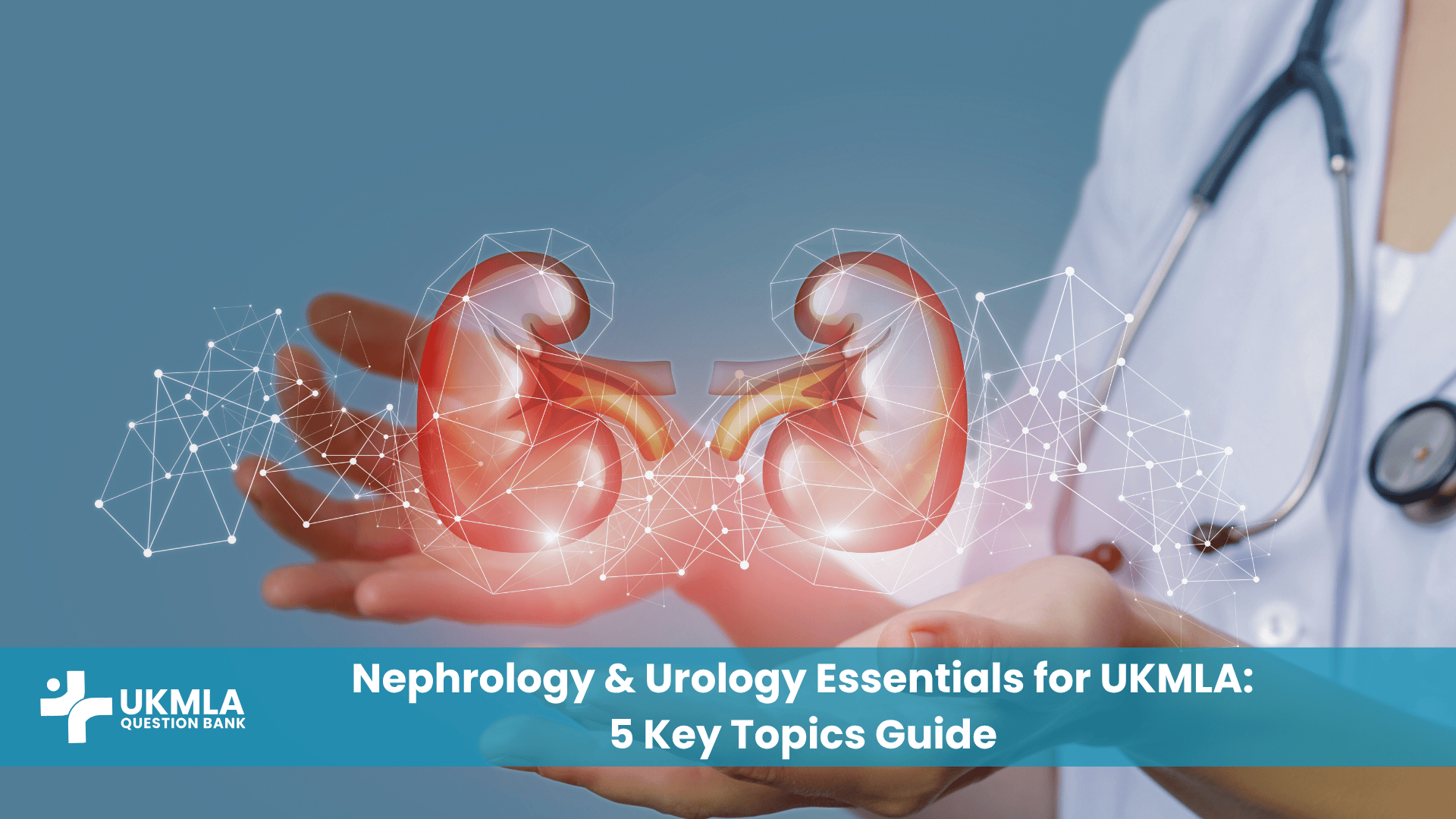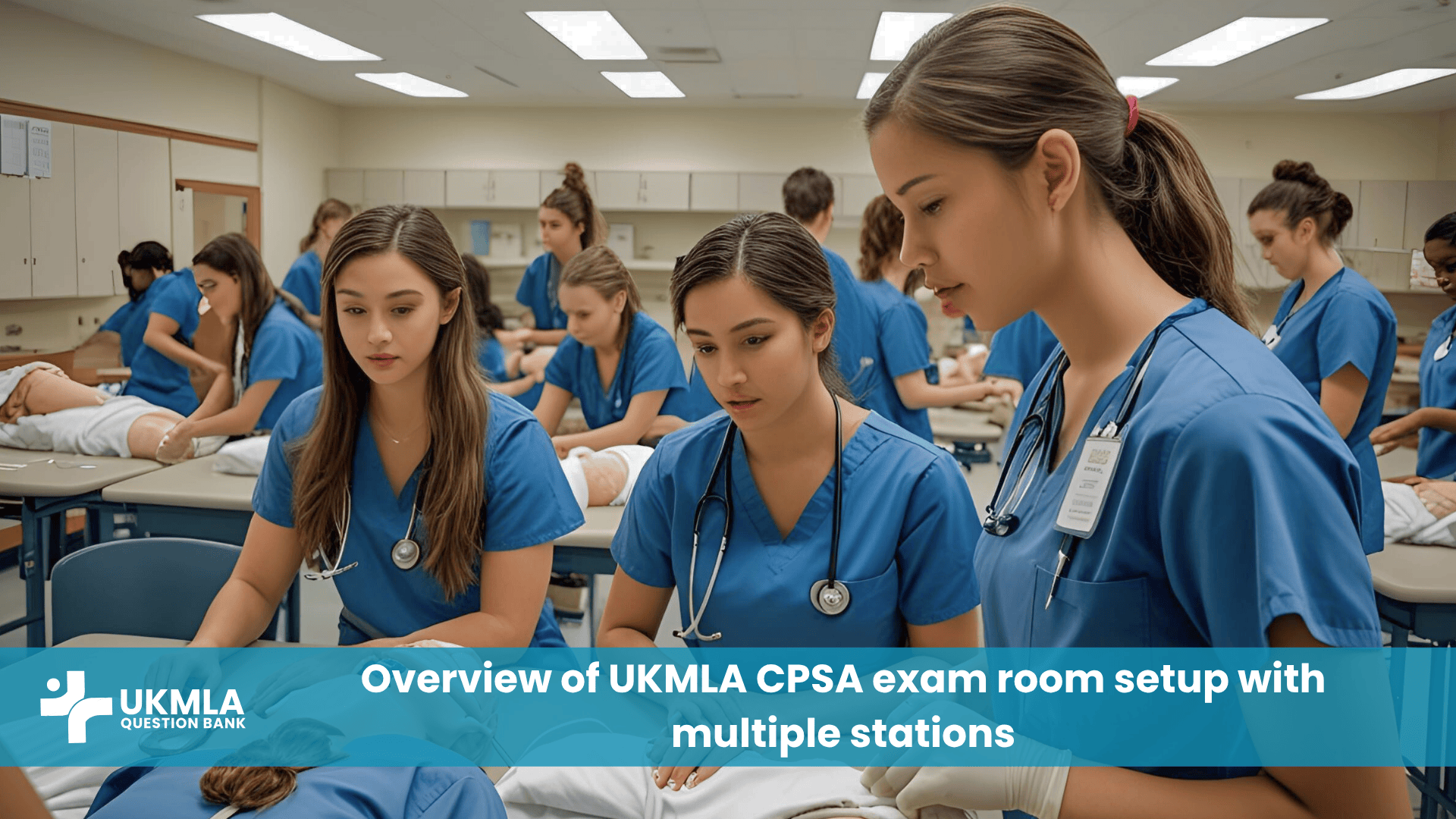Table of Contents
ToggleIntroduction
Understanding the Nephrology & Urology essentials for UKMLA begins on a busy ward, with a scenario every junior doctor will face. You’re asked to review an elderly patient whose urine output has dropped, and their creatinine level is climbing. Is this simple dehydration? Is it an obstructed catheter? Or is it the beginning of a serious intrinsic kidney disease? Your ability to systematically work through this problem, focusing on fluid status, basic investigations, and patient safety, is a core competency that the UKMLA is designed to test.
Renal medicine and urology can seem intimidating. These fields are deeply interconnected and filled with complex concepts like fluid balance, electrolyte disturbances, and acid-base physiology. However, for the UKMLA, you are not expected to be a specialist nephrologist. Your role is to master the essentials: to recognise common and critical conditions, initiate safe and appropriate first-line management, and know when to escalate for specialist help.
This guide provides a structured approach to this vital area of medicine. We will break down the topic into five high-yield areas that are fundamental to both safe clinical practice and exam success. By focusing on these core concepts, you can build a robust framework for your revision and tackle any renal or urology question with confidence.
A Guide to the 5 Key Topics in Nephrology & Urology Essentials for UKMLA
1. Acute Kidney Injury (AKI): A Common Hospital Complication
AKI is defined as a rapid deterioration in kidney function, and it is extremely common in hospitalised patients. The UKMLA will expect you to understand its classification, causes, and immediate management.
Classification and Causes: AKI is staged from 1 to 3 based on the rise in serum creatinine or a fall in urine output. More importantly, you must classify the cause of the AKI, as this dictates the treatment:
Pre-renal: The most common cause, due to reduced blood flow to the kidneys. Think of causes like hypovolemia (dehydration, haemorrhage), sepsis (vasodilation), or medications like NSAIDs and ACE inhibitors which affect renal perfusion.
Intrinsic Renal: There is direct damage to the kidney tissue itself. Causes include glomerulonephritis, acute tubular necrosis (often secondary to prolonged pre-renal injury or nephrotoxic drugs like gentamicin), or acute interstitial nephritis.
Post-renal: Caused by an obstruction to the outflow of urine. This could be “high” obstruction (e.g., kidney stones in the ureters) or “low” obstruction (e.g., an enlarged prostate in BPH, a blocked catheter, or a pelvic mass). An urgent ultrasound of the renal tract is the key investigation here.
Key Point: The first step in managing any patient with a potential AKI is a thorough fluid status assessment. Are they hypovolaemic (dry, tachycardic, low JVP – suggesting a pre-renal cause) or fluid overloaded (oedematous, crackles on auscultation – suggesting an intrinsic renal or cardiac problem)? This clinical assessment is vital.
Immediate Management (The “AKI Bundle”): Based on NICE guidelines, once AKI is suspected, you must act fast. This includes stopping nephrotoxic drugs (like ACE inhibitors, ARBs, NSAIDs, and certain antibiotics), ensuring the patient is fluid-resuscitated to a state of euvolaemia, treating any underlying sepsis, and closely monitoring their fluid balance and biochemistry.
2. Chronic Kidney Disease (CKD): Staging and Proactive Management
CKD is a long-term decline in kidney function. Unlike the urgency of AKI, management here is focused on slowing the rate of progression and managing complications. For a deeper dive into managing long-term conditions, our guide on General Practice Essentials for UKMLA is a valuable resource.
Staging: CKD staging is crucial for assessing risk and guiding management. It is based on two factors: the eGFR (G stage) and the Albumin:Creatinine Ratio (ACR) (A stage).
Table 1: Staging of Chronic Kidney Disease (CKD) – KDIGO Heatmap
| GFR Stage (eGFR, ml/min/1.73m²) | A1: Normal to Mildly Increased (ACR <3 mg/mmol) | A2: Moderately Increased (ACR 3-30 mg/mmol) | A3: Severely Increased (ACR >30 mg/mmol) |
|---|---|---|---|
| G1: ≥90 (Normal or High) | Low Risk | Moderate Risk | High Risk |
| G2: 60-89 (Mildly decreased) | Low Risk | Moderate Risk | High Risk |
| G3a: 45-59 (Mild-moderately decreased) | Moderate Risk | High Risk | Very High Risk |
| G3b: 30-44 (Moderate-severely decreased) | High Risk | Very High Risk | Very High Risk |
| G4: 15-29 (Severely decreased) | Very High Risk | Very High Risk | Very High Risk |
| G5: <15 (Kidney Failure) | Very High Risk | Very High Risk | Very High Risk |
Management Principles: Key interventions include strict blood pressure control (often with an ACE inhibitor or ARB as they reduce proteinuria), optimizing glycaemic control in diabetics, and managing complications such as anaemia (with erythropoietin) and mineral bone disease (with phosphate binders and vitamin D analogues).
3. Glomerulonephritis: The Nephritic vs. Nephrotic Framework
Glomerulonephritis (GN) covers a range of complex conditions involving inflammation of the glomeruli. For the UKMLA, the key is not to memorise every subtype but to recognise the two major clinical syndromes they cause.
A Word from a Renal Physician: “For a junior doctor, the specifics of every glomerulonephritis are less important than recognising the two main clinical syndromes. If you see haematuria, hypertension, and oliguria, think ‘nephritic’. If you see massive proteinuria, peripheral oedema, and hypoalbuminaemia, think ‘nephrotic’. This initial pattern recognition is key to guiding the right specialist investigations.”
Nephritic Syndrome: Caused by inflammation in the glomeruli, which allows blood and some protein to leak through. The classic features are haematuria (blood in urine, often described as ‘coke-coloured’), hypertension, oliguria (low urine output), and mild proteinuria. A classic example is post-streptococcal glomerulonephritis.
Nephrotic Syndrome: Caused by damage to the glomerular basement membrane, leading to the leakage of huge amounts of protein. The classic features are massive proteinuria (>3.5g/day), severe peripheral oedema (due to low oncotic pressure), and hypoalbuminaemia. A classic example in children is Minimal Change Disease.
4. Common Urological Conditions: UTI, BPH, and Kidney Stones
This section covers the high-yield urology topics essential for a Foundation doctor.
Urinary Tract Infections (UTIs): You must differentiate between uncomplicated UTIs (in non-pregnant, healthy adult women), which can be treated with a short course of oral antibiotics, and complicated UTIs (in men, pregnant women, catheterised patients, or those with signs of pyelonephritis), which require a longer course and potentially hospital admission.
Benign Prostatic Hyperplasia (BPH): A very common cause of lower urinary tract symptoms (LUTS) in older men. Key symptoms include hesitancy, poor stream, and terminal dribbling. Management involves alpha-blockers (e.g., Tamsulosin) to relax the smooth muscle and 5-alpha-reductase inhibitors (e.g., Finasteride) to shrink the prostate.
Kidney Stones (Renal Colic): The classic presentation is a sudden-onset, severe, loin-to-groin pain that makes the patient unable to sit still. Non-contrast CT KUB is the gold standard investigation. Management involves strong analgesia (often an NSAID like diclofenac, if no contraindications) and hydration.
Table 2: Differentiating Common Urological Presentations
| Condition | Classic Symptoms | Key Investigation Findings | First-Line Management Principle |
|---|---|---|---|
| Uncomplicated UTI | Dysuria, frequency, urgency. | Urine dipstick: positive for nitrites and/or leukocytes. | 3-day course of oral antibiotics (e.g., Nitrofurantoin). |
| Benign Prostatic Hyperplasia (BPH) | Hesitancy, poor stream, nocturia, terminal dribbling. | Digital Rectal Exam (DRE): smooth, symmetrically enlarged prostate. Consider PSA test. | Medical therapy (alpha-blockers) or surgical (TURP). |
| Renal Colic (Kidney Stones) | Sudden, severe, colicky loin-to-groin pain. Haematuria. | Urine dipstick: often positive for blood (haematuria). Non-contrast CT is gold standard. | Strong analgesia (e.g., NSAIDs) and hydration. |
5. Key Electrolyte Disturbances: Hyperkalaemia & Hyponatraemia
Disordered electrolytes are common in renal patients and can be life-threatening. You must know the emergency management of hyperkalaemia and the framework for assessing hyponatraemia.
Hyperkalaemia (High Potassium): This is a medical emergency due to its risk of causing fatal cardiac arrhythmias. Causes include AKI, certain drugs (ACE inhibitors, spironolactone, NSAIDs), and rhabdomyolysis.
Key Point: An ECG is mandatory in any patient with significant hyperkalaemia (>6.0 mmol/L) or any patient with hyperkalaemia and symptoms. Look for classic changes like tall, tented T waves, a widened QRS complex, and eventually a ‘sine wave’ pattern. The immediate priority is to give intravenous calcium gluconate to stabilise the cardiac membrane and prevent arrhythmia.
Hyponatraemia (Low Sodium): The key to managing hyponatraemia is to first assess the patient’s fluid status.
Hypovolaemic Hyponatraemia: The patient is dehydrated (e.g., from diarrhoea, vomiting, diuretic overuse). The treatment is to give intravenous 0.9% saline.
Euvolaemic Hyponatraemia: The patient’s fluid status is normal. This is the classic picture for the Syndrome of Inappropriate ADH (SIADH). The treatment is fluid restriction.
Hypervolaemic Hyponatraemia: The patient is fluid overloaded (e.g., from heart failure, liver failure, or renal failure). The treatment is fluid restriction and diuretics.
Frequently Asked Questions (FAQ) About Nephrology & Urology
The most common culprits to remember are NSAIDs (e.g., ibuprofen, naproxen), ACE inhibitors/ARBs (can precipitate AKI in certain conditions), certain antibiotics like gentamicin, and IV contrast dye used in CT scans.
Haemodialysis involves filtering a patient’s blood through an external machine, typically done in a hospital or dialysis centre 3 times a week. Peritoneal dialysis uses the lining of the patient’s own abdomen (the peritoneum) as a filter, and is usually done by the patient at home every day.
This is the classic finding for Benign Prostatic Hyperplasia (BPH). A hard, craggy, or asymmetrical prostate would be a red flag for prostate cancer.
PSA stands for Prostate-Specific Antigen. It is a blood test used to help detect prostate cancer, but it is not a perfect test. Levels can be raised in other conditions like BPH or prostatitis. It is used as part of the overall assessment, not in isolation.
In patients with CKD and proteinuria (especially diabetics), ACE inhibitors (or ARBs) are first-line for managing hypertension. They have a specific protective effect on the kidneys by reducing intraglomerular pressure, which helps to slow the progression of the disease.
Pyelonephritis is an infection of the kidney itself. In addition to UTI symptoms (dysuria, frequency), patients will have systemic signs like fever, rigors, vomiting, and loin/flank pain.
Rapid correction of chronic low sodium can lead to a devastating neurological condition called osmotic demyelination syndrome (formerly central pontine myelinolysis), which can cause paralysis, dysphagia, and other severe neurological deficits.
This is the classic description of pain from a kidney stone (renal colic). The pain starts in the loin (the flank/side of the back) and radiates downwards and forwards towards the groin as the stone moves down the ureter.
eGFR stands for estimated Glomerular Filtration Rate. It is a calculation based on the serum creatinine level, age, sex, and ethnicity, and it is used to estimate how well the kidneys are filtering waste from the blood. It is the primary measure used to stage CKD.
MSU stands for Mid-Stream Urine. It is the standard method for collecting a urine sample for culture to minimise contamination from skin bacteria. The patient starts urinating into the toilet, then catches the “mid-stream” portion of the urine in a sterile pot.
Conclusion
The Nephrology & Urology essentials for UKMLA are built on a foundation of core principles rather than encyclopaedic knowledge. If you can master the systematic approach to AKI, understand the proactive management goals of CKD, recognise the key patterns of glomerulonephritis, confidently manage common urological conditions, and know the emergency steps for critical electrolyte disturbances, you will be exceptionally well-prepared.
Always ground your learning in the realities of UK clinical practice, using guidelines from official bodies like the GMC and NICE. This principles-based approach will serve you not only in passing the UKMLA but in becoming a safe, competent, and confident Foundation Year doctor.
Call to Action:
Many renal conditions are closely linked to cardiovascular health. Build on your knowledge by reviewing our guide on Cardiology Essentials for UKMLA: High-Yield Conditions and Management.




